Datadesign
Sibel Dural / Lotte den Adel
Anxiety campaign proposal - Alexandra Smith
Darkness & Light
Stands for fear
Stands for solutions and hope
COVID WITH ANXIETY
EXAMPLES OF PROJECTS ABOUT ANXIETY >>>>>>>>>>>>>>>>>>>>>>>>>>>>>>>>>>>>>>>>>>>>>>>>>>>>>>>>>
P3 Data Design
Theme: Data as material. If all data were created equal
In our digital society data has become one of the main currencies in which companies and institutions invest and trade. Data is mined feverishly in order to expose possible connections, associations, patterns and trends that in turn can provide valuable insights into human behavior and interactions. Not only with regard to past and the present, but especially when trying to grasp a glimpse of tomorrow.
In this process not all data is regarded equally valuable. Quantitative data; information about quantities, and therefore numbers, is in this context often seen as more valuable than qualitative data which is descriptive, and regards phenomenons which can be observed but not (easily) measured, such as language. Because of its nature, a lot of potentially valuable data in both the digital and the physical realm remains unnoticed.
In this course you will be challenged to use your creative and critical ability to investigate the significance of undervalued data in your own unique way and share your new insights with specified others through visual storytelling and thoroughly considered and multi-sensory translations.
DATA DESIGN ASSIGNMENT >>>>>>>>>>>>>>>>>>>>>>
THOUGHTS >>>>>>>>>>>>>>>>>>>>>>>>>>>>>>>>>>>>>>>>>>>>>>>>>>>>>>>>>
ANXIETY, Explained.
Anxiety is the most common mental illness.
Fight or flee.
The oh no feeling.
We are filled with fear, stress, anxiety.
- Catastrophic fear
- Fear of avalutation
- Fear of losing Control
- Fear of uncertanty
“The definition of fear and its close relative anxiety, have varied over time...”
We create scenarios that activate these fears.
While breaking those scenarios down, you have to remember that it isnt that bad. You survive!
https://www.nytimes.com/2020/07/28/opinion/tears-teacher-crying-japan.html?searchResultPosition=60
ARTICLES RELATED TO ANXIETY >>>>>>>>>>>>>>>>>>>>>>>>>>>>>>>>>>>>>>>>>>>>>>>>>>>>>>>>>>>>>>>>>>>>>>>>>>>>>>>>>>>>>>>>>>>>>>>>>>>>>>>>>>>>>>>>>>>>>>>>>>>>>>>>>>>>>>>>>>>>>>>>>>>>>>>>>>>>>>>>>>>>>>>>>>>>>>>>>>>>>>>>>>>>>>>>>>>>>>>>>>>>>>>>>
To mimic the feeling, we thought of a light show in an installation.
inspired by our NXT museum visit.
INSTALLATION IDEA? >>>>>>>>>>>>>>>>>>>>>>>>>>>>>>>>>>>
DATA >>>>>>>>>>>>>>>>>>>>>>>>>>>>>>>>>>>>>>>>>>>>
https://www.itsnicethat.com/news/martin-scorsese-lockdown-culture-with-mary-beard-film-290520
https://www.itsnicethat.com/news/where-we-stand-social-distance-design-creative-industry-010720
https://www.itsnicethat.com/news/the-mind-map-mental-health-awareness-publication-030719
FEEDBACK >>>>>>>>>>>>>>>>>
NOTES >>>>>>>>>>>>>>>>>>>>>>>>>>>>>>>>>>>>>>>>>>>>>>>
doelgroep:
studenten tussen de 16 en 23.
Onderwerp: dagbesteding van jongeren (social anxiety) link naar Corona
visueel data verzamelen
vragen:
hoe voelde je je over de sociale veranderingen die zijn ontstaan door COVID
en hoe voelde je je voor deze veranderingen
maak je gevoel visueel door 4 vakjes je gevoel door een krabbel te omschrijven
beschrijf je anxiety over het missen over je sociale contacten of social distancing
issue waat we ons op focussen
- doelgroep specialiseren
- meer data erin verwerken als in een patroon om ons verhaal wat sterker te maken
- hoe kunnen we hard maken wat we zeggen
- duidelijke lijn trekken
- richting en lijn wat specifieker maken
- met wat voor middelen zouden we willen werken maar niet teveel aan vast klampen
- focussen op 1 onderwerp binnen anxiety
- kunnen we online data basses vinden die er al bestaan over dit onderwerp?
- prototype hoe het mensen beïnvloed dus uittesten
- hot glue overzichtelijker maken
- wat is onze specifieke onderzoeksvraag?
- kijken bij andere mensen hoe ze het ervaren en daar specifieke vragen over stellen en antwoorden bij elkaar gaan leggen.
visueel data verzamelen
vragen:
Data design
Did covid have effect on your social anxiety?
Are you feeling more alone?
Do you have anxiety of missing out?
anxiety of missing school?
>> prestatie gaat achteruit.
Altijd mee bezig zijn >> waar je ook heen gaat!
Is it a good time to go to the shop now or is it to busy etc etc.
Not everyone thinks about it that much but that can bring contrast.
Social distancing
fear of contamination
1. fear of getting covid.
2. fear of giving covid.
1. fear of social anxiety
2. fear of losing control (losing structure and not knowing)
3. fear of contamination
4. fear of missing out (time goes on)
COLLECTING DATA >>>>>>>>>>>>>>>>>>>>>>>>>>>>>>>>>>>>>>>>>>>>>>>>>>>>>>>>>>>
DATADESIGN P3 THEORY >>>>>>>>>>>>>>>>>>>>>>>>>>>>>>>>>>>>>>>>>>>>>>>>>>>>>>>>>>>
Undigitalization, where to start? In a world where we react to every problem with a digital solution, this led to a life where we can’t go without. But are there still elements that we can’t make digital? Something that can’t be made through coding.
The first subjects we thought about were the experience of dreaming, physical contact, mental and physical illnesses, emotions, thoughts and total randomness. Things that we can’t fully explain, and there is always a part unpredictable. Code is predictable and can never be 100% random. These months that we have experienced in a pandemic have been times we had to adjust to the measures that came because of covid. We totally understand the situation, but it still changed our lives and the things we would normally do, day to day. With this pandemic came more than only the virus, it came with a lot of anxiety and loneliness.
We both are experiencing a feeling of losing time. Our social lives are now on a hold, but time goes on. The urge to see our friends and have a dance on the dancefloor is so high and we can’t. This brings some loneliness and anxiety with it. We noticed that the people around us had a similar experience because a big part of our lives fell apart. Anxiety is the most common mental illness and our social lives falling apart did net help. We read a few articles related to anxiety and a documentary where they explain anxiety.
During this study, the project of 15 design firms appealed to us the most. These 15 agencies had made designs for a social distancing city in which everything was adapted to see each other and distance themselves in a fun but safe way. Think of a football field that has been changed with color surfaces that you can only stand in, this was made to keep a safe distance and you can still do the social activities with others.
The NXT museum also inspired us. By entering the installation the lights and darkness gave a certain stomach feeling. It was so intense and we thought it would be interesting to use in our experience of anxiety. Not to mimic it and give people panic attacks but to tell them that they are not alone and show stories of others. But how can we make such a story clear through a light show? So we took a step back and started with the data we want and need to collect. We want to target the ages between 16 and 25 because we can relate ourselves.
What do we want to know? Are you feeling more alone? Do you have anxiety of missing out? Fear of contamination? and even the fear of losing control and not knowing what is going to happen?
In what form do we collect the data? Anxiety is something personal and hard to talk about. We wanted to make it easier for them to describe their feelings in a visual way that gives them less pressure. We first wanted to let them draw their feelings but that is still a lot to ask and we needed to be physical with them. Our target group is known for showing their feelings through emojis. To collect as much data as possible we tried to approach people through social apps, such as whats app and instagram.
Our research question: Can you explain how you are feeling about your social life during this pandemic? Through emojis (20max) and please put your age at the end. example: 😩😷🌬🥺🤨😒☠️💩🤡🙇🏽♀️🤷🏽♀️22
We formulated our question in such a way that they didn’t feel pressured with the loaded word “anxiety”. The emojis we received told stories and their feelings about the whole situation. The fact that so many people responded made it clear that they felt comfortable with the question and the use of emojis. After we collected the data from our target group. We noticed the overload of crying, sad, annoyed and stressed emojis. This tells a story of the situation and what it does to us.
After we researched databases that already existed on the same subject and collected our own data. What can we do as graphic designers? To make as much impact as possible on the specific target group and to support them in this difficult time. Our goal with our final publication is to give the feeling that you are not alone with those feelings. And we want to take away part of that loneliness instead of, for example, arousing the feeling of anxiety by imitating it. This will lead to people feeling worse and that is not what we want. We want to show the feelings of others and we aim it to be sort of a supporting system.
What next? How can we decipher the data we received? Are some emojis used more than others? What stories do you get out of them? Are some emojis only readable next to each other? Maybe we can come to conclusions with the information we get from the data and find patterns.
www.itsnicethat.com. (n.d.). Designs for a socially distanced city by Mother Design, Accept & Proceed, DesignStudio and more. [online] Available at: https://www.itsnicethat.com/news/where-we-stand-social-distance-design-creative-industry-010720 [Accessed 16 Oct. 2020].
DATADESIGN PRESENTATION MID-TERM >>>>>>>>>>>>>>>>>>>>>>>>>>>>>>>>>>>>>>>>>>>>>>>>>>>>>>>>>>>>>>>>>>>>>>>>>>>>>>>
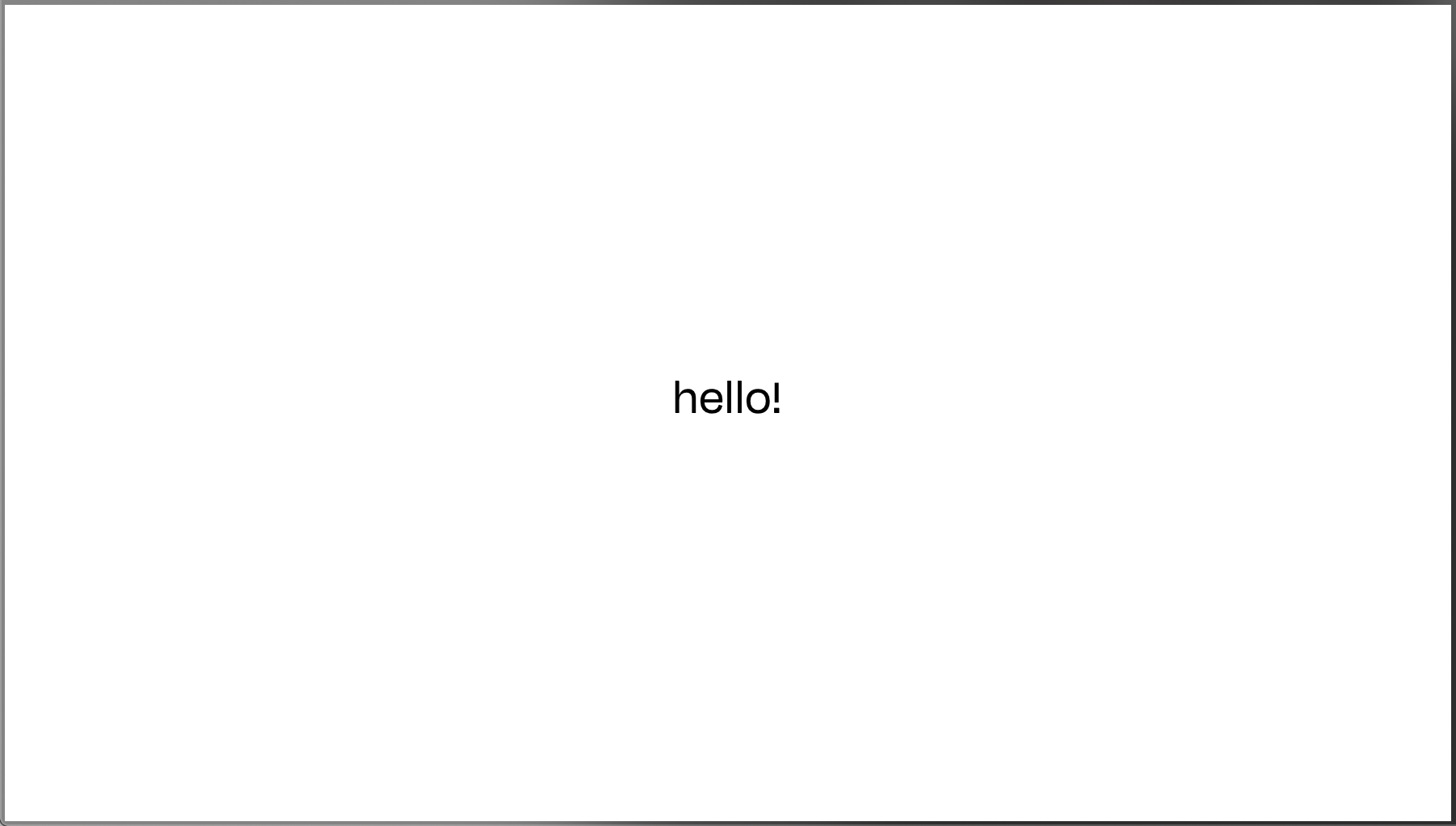

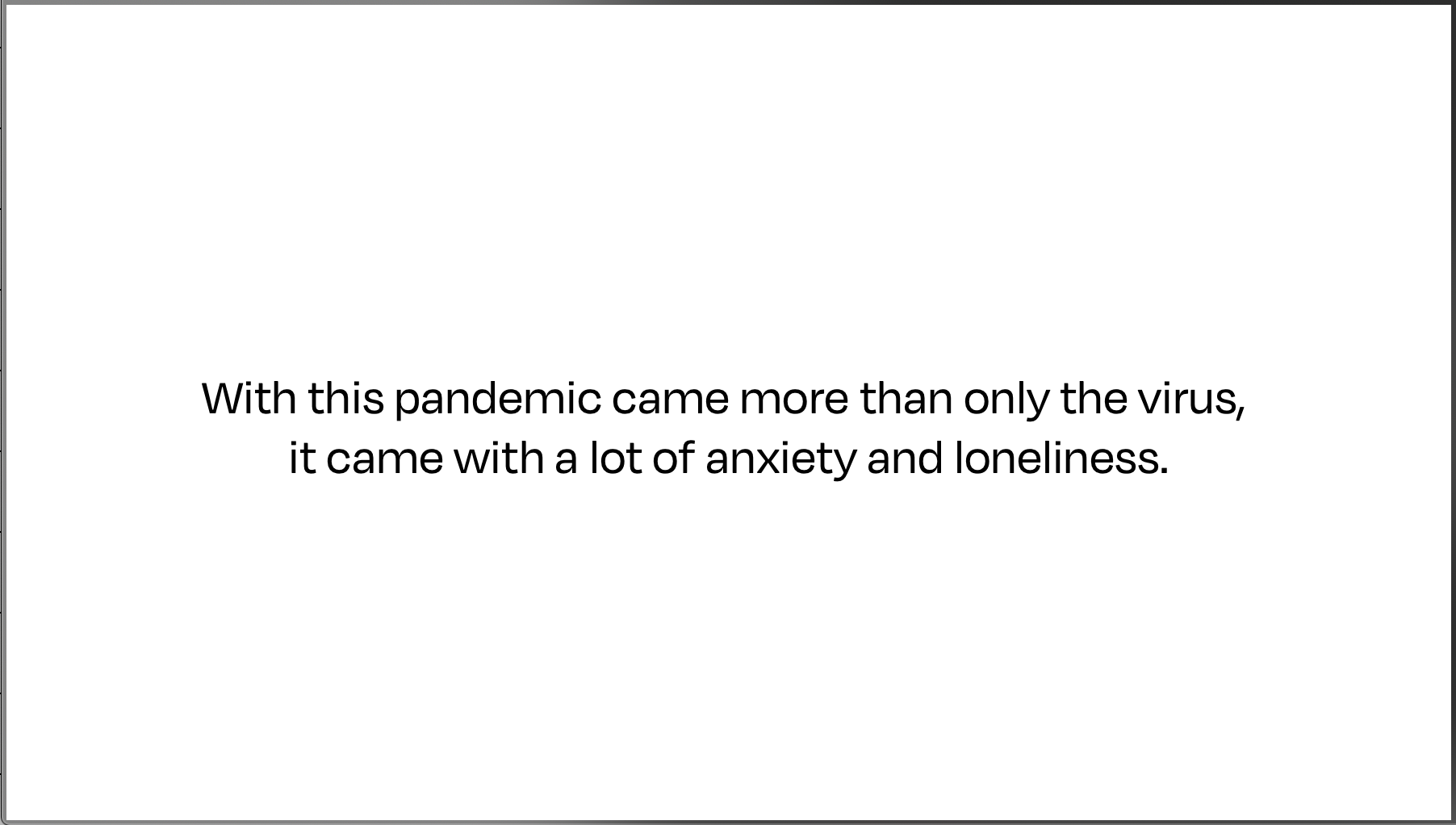
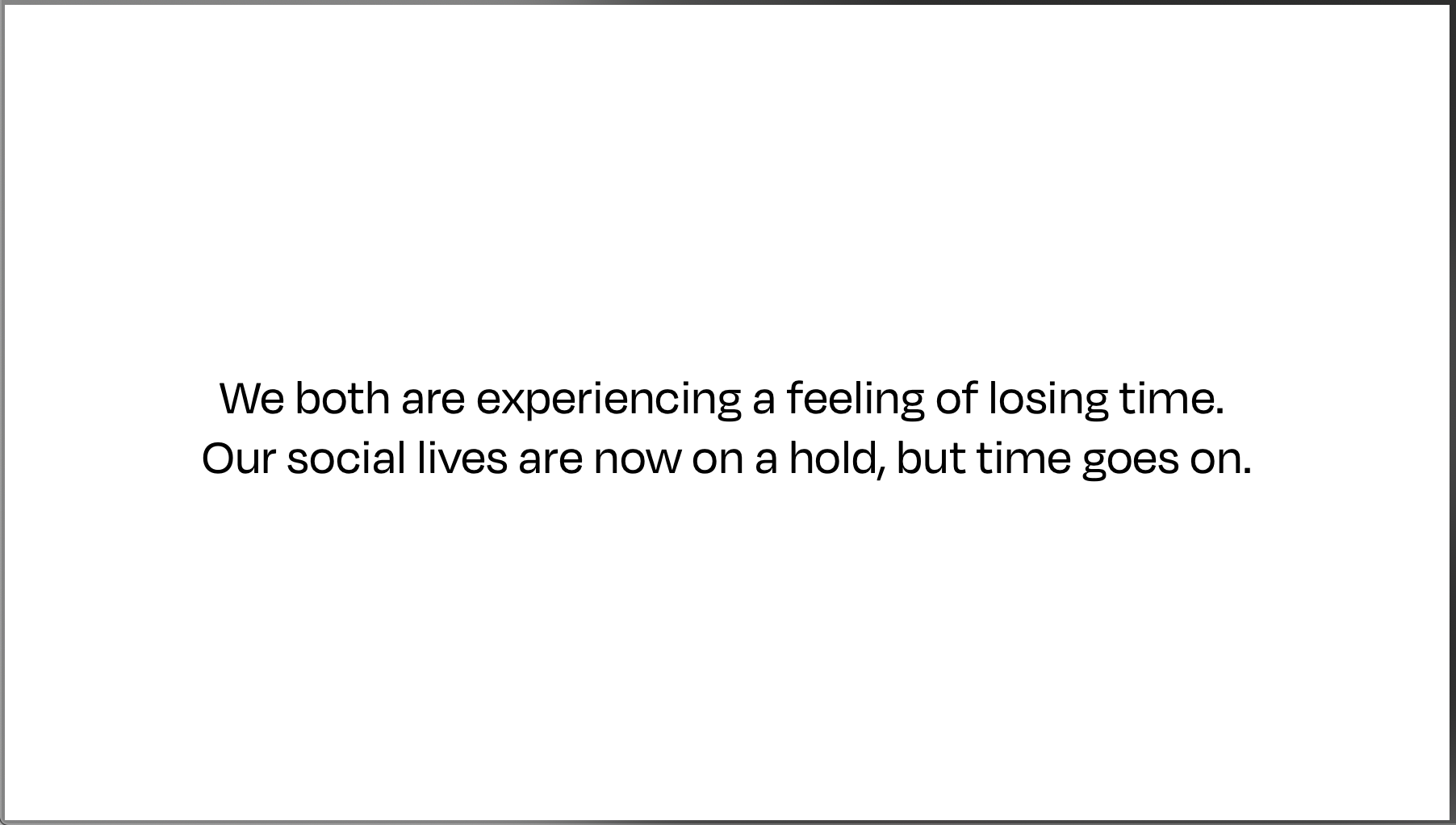
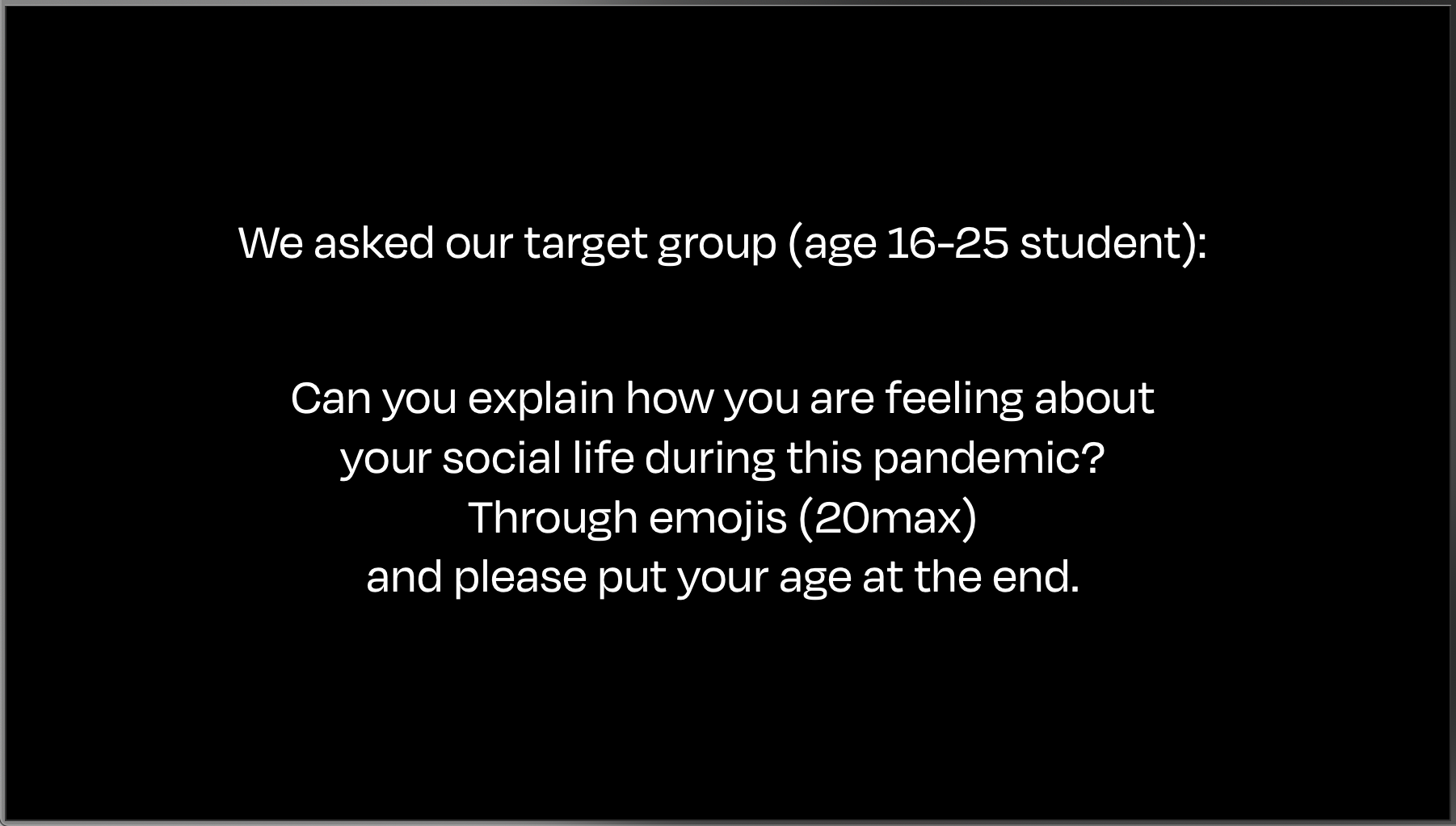
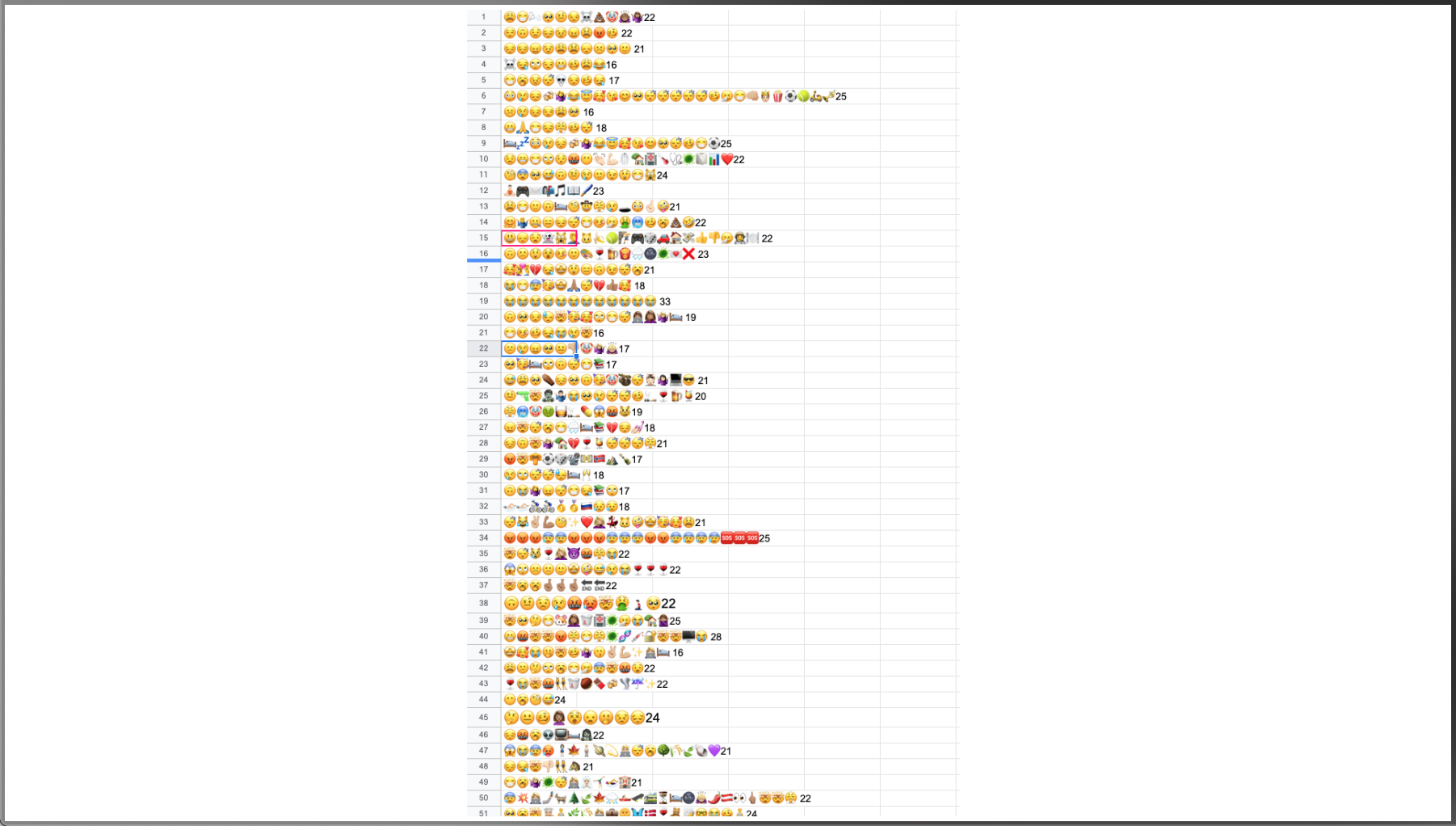

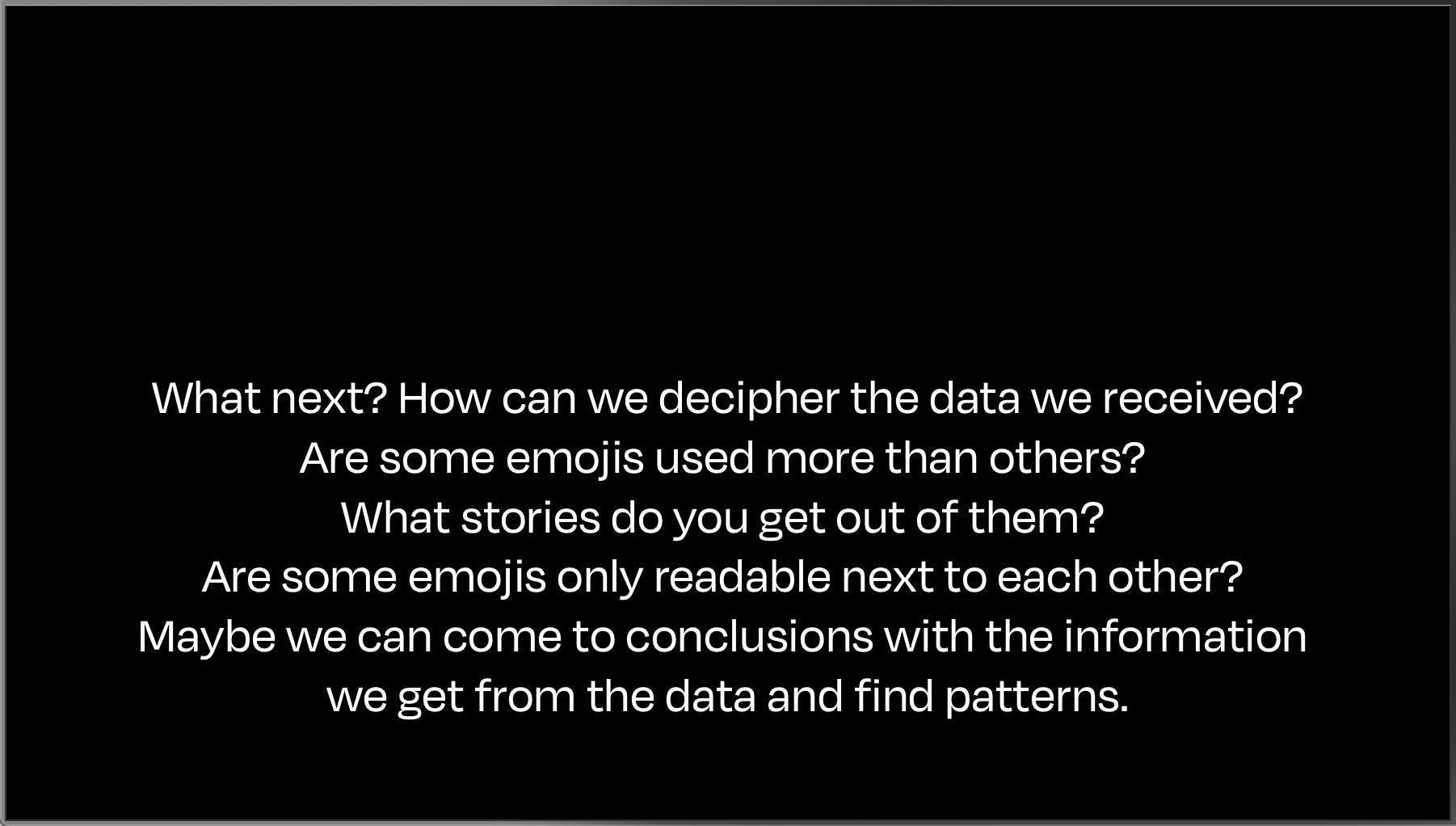
In what form do we collect the data?
Anxiety is something personal and hard to talk about. We wanted to make it easier for them to describe their feelings in a visual way that gives them less pressure. We first wanted to let them draw their feelings but that is still a lot to ask and we needed to be physical with them.
Our target group is known for showing their feelings through emojis.
To collect as much data as possible we tried to approach people through social apps, such as whats app and instagram.
Our research question:
Can you explain how you are feeling about your social life during this pandemic? Through emojis (20max) and please put your age at the end. example: 😩😷🌬🥺🤨😒☠️💩🤡🙇🏽♀🤷🏽♀22
We formulated our question in such a way that they didn’t feel pressured with the loaded word “anxiety”. The emojis we received told stories and their feelings about the whole situation. The fact that so many people responded made it clear that they felt comfortable with the question and the use of emojis. After we collected the data from our target group. We noticed the overload of crying, sad, annoyed, and stressed emojis. This tells a story of the situation and what it does to us.
Undigitalization, where to start? In a world where we react to every problem with a digital solution, this led to a life where we can’t go without. But are there still elements that we can’t make digital? Something that can’t be made through coding.
https://www.itsnicethat.com/news/inclusive-emojis-world-emoji-day-apple-we-are-social-rnib-170719
On World Emoji Day, two groundbreaking campaigns are making emojis more unclusive.
https://www.itsnicethat.com/news/apple-emoji-digital-260318
Apple create emoji set to better represent users with diabilities.
https://www.itsnicethat.com/articles/gavin-lucas-the-story-of-emoji-060416
The Story of Emoji told with <3 by Gavin Lucas.
Emojis have a general meaning/description.
What the emoji supposed to tell and/or look like.
It's a digital way of talking and we can make use of that.
Can we translate the train of emojis that is sent to us?
Can we make a textual version?
Is it accurate? Or tells it something more about the undigitizable part.
How would the computer read it? translate it?
🤯🥱🥱🤞🏽🤞🏽🤞🏽🔚🔚22
I am mind blown and really really tired.
Hoping so so so much that this will end soon.
😢🤷🏼♂️🧐😑🙄😒😫🥱🤖26
I am sad and confused.
I don't know
trying to understand.
NOTES
Like button dat word steeds anders geinterpreteerd.
Gebruiker kiest ipv wij voor hun
Project is een soort poezie
Wat gebeurd er als je vraag nog een keer stelt maar dan je niet te meest gebruikte emoji mag gebruiken.
Kan emojis therapeutisch werken? (Psygoloog)
Smileys zijn een toevoeging aan je bericht. Dit doe je omdat ze je gezicht niet kunnen zien.
als psygologische tool??
Gebruik emojis om je gevoel te uiten.
Like button is heel breed en je keus word minder zodra je uit meerdere emojis kan kiezen. het word specifieker en minder algemeen
Sommige mensen zien de verschillen niet tussen veel emojis
De emojis zijn lastig te lezen voor sommige mensen
Door meer gebruik te maken van emojis word je understanding of the meaning of a specific emoji duidelijker en makkelijker te gebruiken.
Veel emojis worden ook in Slang taal gebruikt.
Onders vooral 'jongeren' zijn er nog meer betekenissen ontstaan.
Communication and interpretation
WHAT CAN WE DO?
Show people an emoji and let them react to it with their own facial expressions. let them mimic it.
Or maybe let them describe it? or describe the situation they would use it in?
TARGET AUDIENCE?
Maybe an online filter?
online #
online because of covid shizzle
What is our goal?
Who is our target audience? more specific
What do we want to achieve?
Come up with more prototype ideas?
NOTES
Use your database
personal emotional stories? that are attached to the train of emojis.
DATABASE is easy to analyze >> Quantify it?
or keep it on a more story level?
Miriam Rasch talked about the like button
like / dislike
now we have more choice that's more specific >> emojis
FIND SIMILAR PROJECTS > TO HELP
Didrik Boemschoten > project on loneliness
Maybe the time is interesting?
interviews?
Try out more ages?
FEEDBACK MID-TERM >>>>>>>>>>>>>>>>>>>>>>>>>>>>>>>>>>>>>>
EMOJI PROJECT EXAMPLES >>>>>>>>>>>>>>>>>>>>>>>>>>>>>>>>>>>>>>>>>>>>>>>>>>>>>>>>>>>>>>>>>>>>>>>>>>>>>>>>>>>>>>>>>>>>>>>>>>>>>>>>>>>>>>
MEANING? IDEA? >>>>>>>>>>>>>>>>>>>>>>>>>>
FEEDBACK >>>>>>>>>>>>>>>>>>>>>>>>>>>>>>>>>>>>>>>>>>>>>>>>>>>>>>>>>>>>>>>>
WHAT NEXT? >>>>>>>>>>>>>>>>>>>>>>>>>>>>>>>>>>>>>>>>>>>>>>>>>>>>>>>>>>>>>>>>
Veranderd de betekenis van een zin door emojis weg te halen?
Wat is het resultaat van een week lang praten met alleenmaar emojis?
Jongeren en ouderen interpreteren emojis op een andere manier.
Uitleg tool voor ouderen??
Alles in themas zetten en kiezen?!
(voorbeeld: interactie / corona / communicatie )
App waarin je kan biechten?
door emojis te gebruiken voelt het minder bezwaard.
Verhaaltje van emoji naar mensen sturen en kijken hoe ze het interpreteren?
INSPIRATION >>>>>>>>>>>>>>>>>>>>>>>>>>>>>>>>>>>>>>>>>>>>>
INSTAGRAM
@staysanestaysafe
@studio_lennartsendebruijn
@overdeschreef
56 meticulously selected posters and 4 explanatory ones make up a total of 60 bangers in beautiful lightboxes.
PLANNING COMING WEEKS >>>>>>>>>>>>>>>>>>>>>>>>>>>>>>>>>>>>>>>>>>>>>>>>>>>>>>>>>>>>>>>>>>>>>>>>>>>>>>>>>>>>>>>>>>>>>>>>>>>>>>>>>>>>>>>>>>>>>>>>>>>>>>>>>>
07/Dec - 11/Dec
Presentations
React on previous prototype results.
Maybe work towards the end presentation?
(It can take longer than one week)
Finish up
Create a story time book?
generator?
30/Nov - 04/Dec
Feedback rounds on concepts
PROTOTYPE:
We can make the prototype of week 23/27 look like a game?
(You have the filters on Instagram/Snapchat/TikTok where you have to mimic something or answer questions.)
Maybe this will reach a larger audience online via social media. Most of the people that follow us are our target audience.
23/Nov - 27/Nov
Feedback rounds on concepts
PROTOTYPE:
The animation from week 16/20 is made with emojis.
Now we want to ask our target audience to mimic the emojis with masks. to see if they know their original emoji expressions.
After this, we can show the video to the target audience and ask if they feel the same and if it has the same meaning for them as in general.
16/Nov - 20/Nov
Narrative setup
Prototype brainstorm >> coming weeks
PROTOTYPE:
We interpret emojis in a certain way, and now during this pandemic, we are missing facial expressions because of the masks.
Is this also with emojis? Can we read them without that part of the face? Or do they all look the same?
Maybe we can make an animation that switches between original emojis and emojis with the masks.
TARGET AUDIENCE?
At first, we started with students and the younger generation with the ages of 16 - 25.
We are now interested in the way people interpret different emojis and there is a bigger contrast between older and younger people.
Maybe extend toward older people (40 - 60)?
But now in this time, it is hard to ask the older generation because we want the respect the distancing. And online is not their cup of tea.
To be productive we decide to stay with the younger audience and this will maybe have a smaller contrast but there is still a difference and that can we interesting also.
16/NOV - 20/NOV >>>>>>>>>>>>>>>>>>>>>>>>>>>>>>>>>>>>>>>
PROTOTYPE:
We interpret emojis in a certain way, and now during this pandemic, we are missing facial expressions because of the masks.
Is this also with emojis? Can we read them without that part of the face? Or do they all look the same?
Maybe we can make an animation that switches between original emojis and emojis with the masks.
FEEDBACK JEROEN
- Idee interpretatie interessant
- Wat wil je gaan interpreteren
- Je kunt ze niet los neerzetten en vragen wat betekend dit
- Dit moet in combinatie met een zin
- Terugkijken naar vorige data
- Stel je vind wel de doelgroep die je nodig hebt
- Wat nou als je emoji reeks van het begin
- Reeks vertalen naar tekstueel verhaaltje zonder emoji bij oudere doelgroep
PROTOTYPE:
The contrasts between the way different people interpret an emoji is more interesting data to collect.
What we collected before the midterms are personal stories in the form of emojis. We want to use them and see how someone else will translate it.
They are allowed to write it down or a voice recording.
Or we can do it online, to keep the distance.
We use emojis to show emotion and sometimes a certain emoji can be read really literally, but there is a slang translation behind it.
PROTOTYPE:
The textual stories we have collected, tells something.
Can we ask the maker of the emoji story to explain their story and see if it looks like the story that someone else wrote down.
Can we make a generator that gives people a platform to talk about these big topics in the form of emojis. This is an easier way to express feelings.
https://gardeners.nl/case/solliciteren-met-emojis-via-whatsapp/
23/NOV - 27/NOV >>>>>>>>>>>>>>>>>>>>>>>>>>>>>>>>>>>>>>>>>>>>>>>>>>>>>>>>>>>>>>>>>>>>>>>>>>>>>>>>>>>>>>>>>>>>>>>>>>>>>>>>>>>>>>>>>>>>>>>>>>>>>>>>>>>>>>>>>>>>>>>>>>>>>>>>>>>>>>>>>>>>>>>>>>>>>>>>>>>>>>>>>>>>>
What are we going to ask?
😢🤷🏼♂️🧐😑🙄😒😫🥱🤖26
Here you can see someone's story of how they experienced and felt about their social life during this pandemic. Can you write down their story in words?
GENERATOR WEBSITE
Generator website where you only see series of stories written with only emojis with related topics. The user could click a story series here within a topic and see what the user wanted to tell with it and what an outsider thought he meant by this so that you can see that emojis have a meaning for everyone and if you use them without a textual sentence it for everyone gets a different meaning.
30/NOV - 04/DEC >>>>>>>>>>>>>>>>>>>>>>>>>>>>>>>>>>>>>>>>>>>>>>>>>>>>>>>>>>>
PROTOTYPE:
The contrasts between the way different people interpret an emoji is more interesting data to collect.
What we collected before the midterms are personal stories in the form of emojis. We want to use them and see how someone else will translate it.
They are allowed to write it down or a voice recording.
Or we can do it online, to keep the distance.
We use emojis to show emotion and sometimes a certain emoji can be read really literally, but there is a slang translation behind it.
07/DEC - 11/DEC >>>>>>>>>>>>>>>>>>>>>>>>>>>>>>>>>>>>>>>>>>>>>>>>>